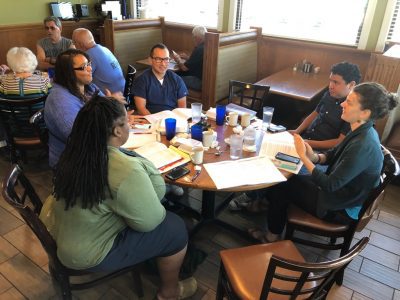Disciple Making Movements
What is a Disciple Making Movement?
A powerful move of God is sweeping around the globe. It started in India but it’s rocking the world. In suburbs of San Francisco, slums of Central America, among Muslim tribes of Africa, and across cast in India, the lost are being won, disciples are being mobilized, and churches are multiplying.
It’s called the “Disciple-Making Movement” (DMM). Although it’s a 21st century phenomena, it’s a return to principles taught by Jesus 2000 years ago.
What is a DMM? A DMM is a combination of several key principles and methods, but at the heart of it is obedience-based small groups with the goal of following Jesus’ command to teach disciples to “obey everything” that he commanded us. (Matthew 28:18-20)
One way to introduce you to DMM is to tell you how to start and multiply a typical DMM “Discovery Group.”
Movements begin with prayer. Begin praying with others for your community and the homes and people around you. Perhaps you could begin by prayer walking your neighborhood, or joining with others to fast one day a week, asking God to move in powerful ways where you live, work, and play.
Next, look for someone that is spiritually hungry, someone God’s Spirit is beginning to draw to Christ. This is a foundational principle of DMM. You don’t have to create interest in spiritual things. God is already drawing people. (John 6:44) Find these people so that you can cooperate with God in bringing them into a relationship with Christ. Jesus told his disciples to look for a “person of peace” when they entered a new community. (Luke 10:6) In the same way, in your world look for a person whom the Holy Spirit is already drawing, someone whom God is giving a hunger for himself. You can see many examples of this type of person in the New Testament—people like the woman at the well (John 4) and the centurion Cornelius (Acts 10). They were predisposed to the good news of Christ and introduced new communities and groups of people to him.
Keep in mind, however, that this person might be very different than you. Jesus was very different from the woman at the well and Peter was not personally inclined to reach out to someone like Cornelius. You don’t get to pick the person of peace, God selects them!
Okay, so you have your seeker. Then you invite them to look at the Bible with you to discover what God is like and how he might want to speak to them. But you ideally want to do this on their turf. There are three types of turf when you are reaching out to someone who does not yet know or is new to Christ—your turf, their turf, and neutral turf.
Traditionally in our churches and ministries, we have always tried to get people to our turf—our buildings, our services, our programs, or our small groups in our homes.

I started a Spanish-speaking Discovery Group on neutral turf (in a restaurant) three years ago. I knew very little Spanish but my “person of peace” did not speak English, so I recruited a bi-lingual friend to help. The group led to the birth of a thriving Latino ministry in our church and an online Spanish Christian radio station. https://radio6.citrus3.com:2199/start/radiocristoviene/
But the good news of Jesus is not going to go viral on our turf, it will only go viral when we move it onto their turf. In other words our goal is not to get people to our turf but to let the gospel penetrate and transform our communities. Some of these people will eventually get enfolded into our churches but as groups multiply and new leaders are formed some new and different churches may begin that reach different populations. The ultimate goal is to bring God’s kingdom to our world, not simply to grow an existing church. I think some of you may have just lost interest! But hear me out.
Jesus did not invite the woman at the well to a building, he went to her village. Cornelius did not come to Peter’s house, Peter went—against his own wishes—to Cornelius’ house.
Jesus did not say, “Get people to come and then make them disciples.” He said, “Go…, and make disciples… And I’ll be with you.” (Matthew 28:18-20)
If you meet them on their turf or neutral turf, they can easily invite their friends or family members. Those folks won’t come to your place. But just as Cornelius’ family and coworkers came to his home to hear a new message (Acts 10), and Levi’s friends came to his pad to meet Jesus (Mark 2:13-17), your seeker’s friends will come to their place. Do you realize the foundational importance of this issue? We
are not bringing the community in. We are taking the Good News out into the community to transform it.
Ideally you start with a few people. But you actually only need one person to begin. You don’t invite them to a class or to a series, you just invite them to meet with you to explore what God says in the Bible. It can be a small beginning, one or two people for one or two meetings. If that goes well, you invite them to continue looking at the Bible with you.
When you meet, use the Discovery Group format. The very first time you meet, you should say something like this: “I am going to use a very simple format and questions to guide our time together. Pay attention to what I do because if we decide to continue to meet, in a few weeks from now we will start taking turns asking the questions and facilitating our interaction.” By rotating leadership you will be subtly preparing people to start their own groups later.
Here are the questions to ask in a Discovery Group:
Opening Questions
- What are you thankful for this week? (This question helps teach seekers or those new to Christ how to worship.)
- What is a challenge you are facing? Is there some way our group can help? (This guides people into caring community.)
- Are you aware of a need that someone else has that this group could help with? (This question helps shape a group that extends Jesus’ love to those around it.)
Accountability Questions
- With whom did you share last week’s learnings?
- How did it go with your “I will’s”? (An “I will” is a person’s statement of how they will respond to a Bible passage.)
You, obviously, skip these accountability questions at your first meeting.
Bible Discovery Questions
- What does it say? (Read or tell the story or passage two or three times, perhaps in different translations.)
- How would I say that? (Each person or together as a group try to retell the passage or Bible story in your own words.)
- What can we learn from this passage?
- What must I feel invited to do in response to what I have learned? “I will…” (Each person crafts a statement to tell how they will respond to the passage this week.)
Outreach Question
- With whom will you share what you learned this week?
At some point, it may be soon or it may take quite some time, people will begin to experience God in life-changing ways. They will discover that he is real and wonderful and trustworthy! When this happens, they will say something like, “My friends need to experience this. Would you lead a group for them?” Or, “I would like my family to learn these truths as well. Can I invite them to this group?” This takes discernment but your answer to questions like this should probably be, “No. You should lead a group for them yourself.” There will likely be hesitancy. They will say, “I couldn’t do that.” To which you should respond, “Of course you can. This is very simple. And I will continue to meet with you, to encourage you and help you.”
A person does not need to know the Bible well to lead a Discovery Group. They actually don’t even need to be a Christ-follower yet themselves. They just need to be able to point people to God’s Word—to help them discover its meaning and to help them begin to apply its truths in their lives.
As people begin their own groups, you should continue to meet regularly with these new leaders one-on-one or together. Mentoring and personal coaching are pivotal to growing movements. Relational networks connect leaders as new groups emerge and new churches form.
Key Principles
Keep these principles in mind as you begin to implement the DMM strategy.
- Pray. As I already mentioned, thriving Disciple Making Movements are saturated in prayer. The strategy depends on God not on you. So invite him to be involved. Ask him to guide you. Invite his Spirit to raise up people of peace and put you in touch with them. Pray for guidance, insight and God’s heart and vision.
- Experiment. Like any new strategy, it takes a while to learn the principles and to discover what works best in your setting.
- Mobilize Others. Disciple Making Movements seldom emerge from a single Discovery Group. They are birthed when trained teams are formed that pray, experiment, encourage one another, and learn together.
- Be patient. It takes considerable time to learn the principles, to apply them, and then to see results. Although over time, DMM’s have seen thousands and even millions come to Christ, it’s actually a “mustard seed” strategy (Matthew 13:31-32)—something which starts tiny but in the long run becomes very big. It goes very slow at first, so that later things can move fast. It focuses on a few initially, because the goal in the end is to reach many. So be patient.
- Learn. The best book to read about this is Miraculous Movements, by Jerry Trousdale. The stories in the book come from Africa, but its Biblical principles apply everywhere. I also love Roy Moran’s book Spent Matches, that shows how DMM principles and methods apply to the United States. There is a lot more to Disciple Making Movements than what I have been able to sketch out in this short article, so commit yourself to learn.
Jesus is calling you and me: “Come, follow me, and I will show you how to fish for people!” (Mark 1:17, NLT) If you want to make disciples who make disciples, I encourage you to talk to Jesus about it, and take your next step in the journey with him. One thing I invite you to consider is signing up for the free online training offered at disciplemakingmovements.com. In it you will learn the six habits of multiplying disciples that Jesus’ taught and modeled.
DISCIPLE MAKING MOVEMENTS BLOG POSTS
How Do You Multiply Disciples in Urban Settings?
The Disciple Making Movement (DMM) that is sweeping around the [...]
Multiplying Disciples in North America
How do the Biblical principles captured in the Disciple [...]
The Best Books about the Disciple Making Movement
An amazing move of God is sweeping around the world [...]

